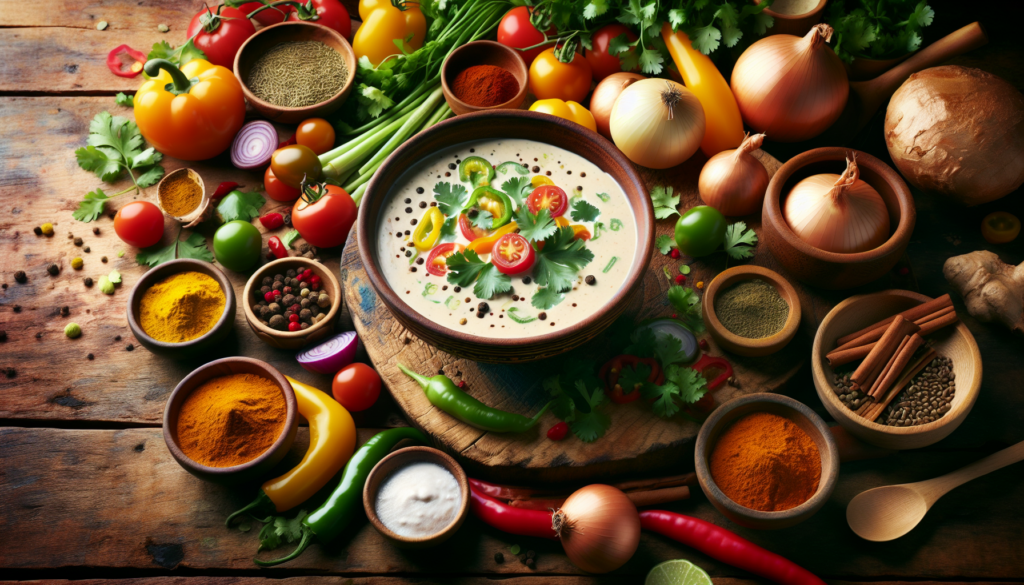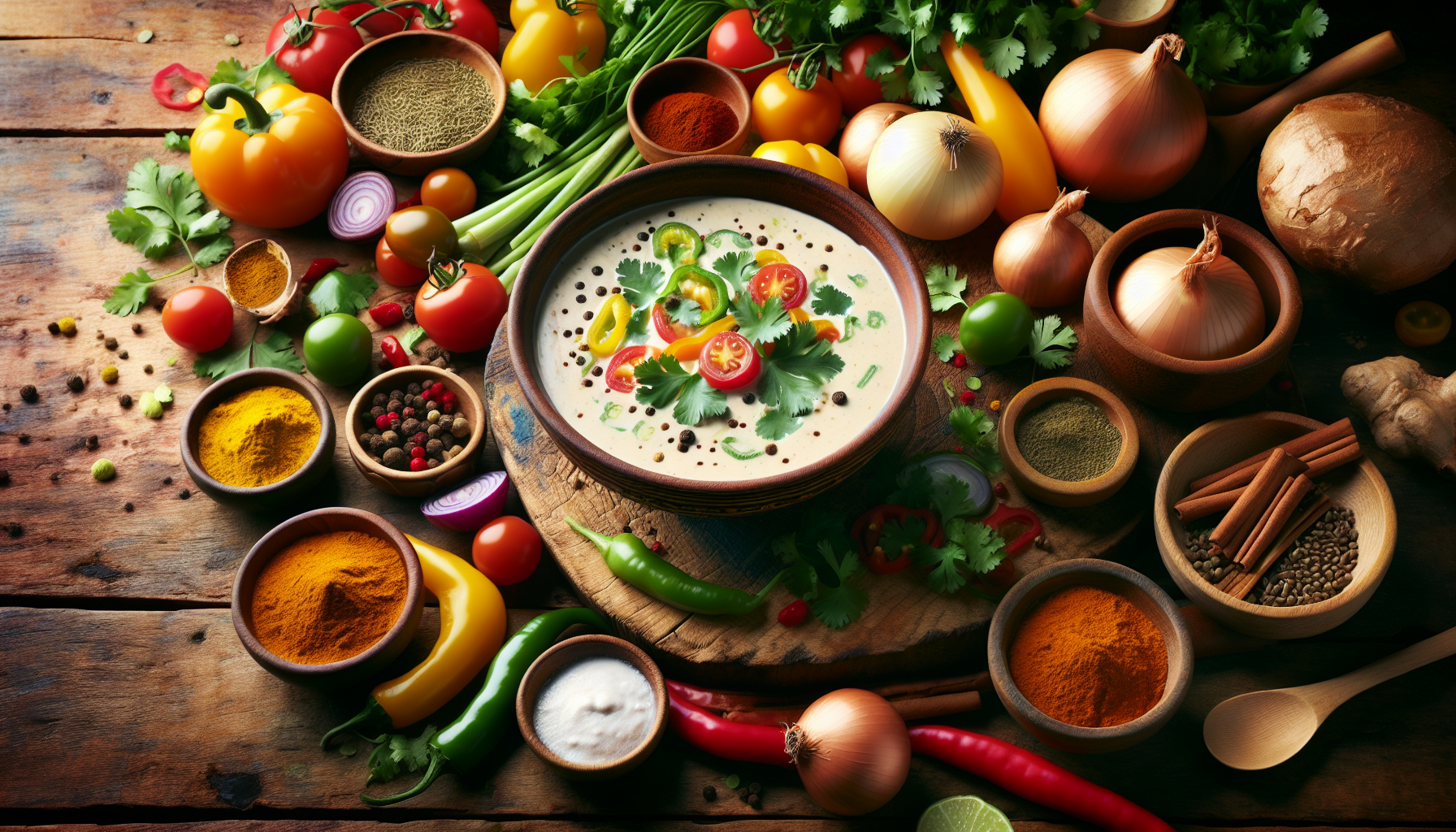In this article, you will discover an incredibly delicious vegan recipe that will transport your taste buds straight to Brazil. Get ready to tantalize your senses with an exquisite dish called Vatapá. This traditional Brazilian delight is a perfect blend of flavors, combining the richness of coconut milk, the satisfying texture of bread, and the zing of various spices. Whether you’re a seasoned chef or just getting started in the world of cooking, this vegan Vatapá recipe is sure to impress and satisfy even the most discerning palates. Get ready to embark on a culinary adventure that will leave you craving for more!

Ingredients
Main Ingredients
To prepare vegan Vatapá, you will need the following main ingredients:
- 2 cups of cooked and peeled yucca (also known as cassava)
- 1 cup of coconut milk
- 1 cup of vegetable broth
- 1 cup of finely chopped onion
- 1 cup of finely chopped bell pepper
- 1 cup of finely chopped tomato
- 1 cup of peanut butter
- 1 cup of bread crumbs
- 1 cup of finely chopped cilantro
- 3 cloves of garlic, minced
- 2 tablespoons of olive oil
- Salt to taste
Spice Blend
For the perfect flavor profile, prepare the following spice blend:
- 1 tablespoon of ground turmeric
- 1 tablespoon of ground cumin
- 1 tablespoon of paprika
- 1 tablespoon of ground coriander
- 1 teaspoon of cayenne pepper (adjust according to your preference)
- 1 teaspoon of black pepper
- 1 teaspoon of salt
Garnish
To add a finishing touch and enhance the presentation of your Vatapá, consider garnishing with:
- Fresh cilantro leaves
- Chopped peanuts
- Sliced limes
Preparation
Step 1: Preparing the Main Ingredients
- Start by cooking and peeling the yucca. It should be soft and easy to mash.
- In a large pot, heat the olive oil and sauté the onion, bell pepper, and garlic until they become translucent.
- Add the tomatoes to the pot and cook until they start to soften.
- Mash the cooked yucca in a separate bowl until it becomes smooth and creamy.
- Stir in the peanut butter, coconut milk, vegetable broth, and bread crumbs into the mashed yucca mixture.
- Mix in the sautéed vegetables and the prepared spice blend. Adjust the salt according to your taste.
- Cook the mixture over medium heat for about 10-15 minutes until it thickens, stirring occasionally.
Step 2: Preparing the Spice Blend
- In a small bowl, combine ground turmeric, cumin, paprika, coriander, cayenne pepper, black pepper, and salt.
- Stir the spices together until well mixed.
Step 3: Cooking Process
- Once the yucca mixture has thickened, reduce the heat to low and let it simmer for another 10 minutes to allow the flavors to blend.
- Stir occasionally to prevent sticking and burning.
- Taste and adjust the seasoning if necessary.
Step 4: Final Touches
- Sprinkle chopped cilantro over the cooked Vatapá to add a fresh herbaceous flavor.
- Garnish each serving with fresh cilantro leaves, chopped peanuts, and a squeeze of lime juice for added brightness.
Tips for Success
Use Fresh Ingredients
Using fresh and high-quality ingredients will elevate the flavors of your Vatapá. Opt for fresh yucca, ripe tomatoes, and vibrant bell peppers for the best results.
Adjust the Spice Level
If you prefer a milder Vatapá, reduce the amount of cayenne pepper in the spice blend. For spice enthusiasts, feel free to add more cayenne pepper or other spicy ingredients according to your preference.
Consistency and Texture
The consistency of Vatapá should be thick and creamy. If your mixture becomes too thick, you can add a little more vegetable broth or coconut milk to achieve the desired texture. Conversely, if it’s too thin, let it simmer for a bit longer to reduce and thicken.
Enhancing the Flavor
For an extra burst of flavor, you can add a splash of lime juice or vinegar to brighten the Vatapá. Additionally, consider adding a pinch of cinnamon or nutmeg to deepen the complexity of the dish.
Serving and Pairing
Serving Suggestions
Vatapá is traditionally served as a main dish with a side of white rice or toasted bread. Another popular serving option is to pour the Vatapá over steamed vegetables, such as cauliflower or broccoli, for a nutritious and satisfying meal. You can also serve it as a dip with plantain chips or toasted pita bread for a flavorful appetizer.
Pairing Options
To complement the rich and savory flavors of Vatapá, consider serving it with a fresh salad or some pickled vegetables. You can also serve it alongside grilled vegetables or tofu for a complete and balanced vegan meal.

Variations and Substitutions
Gluten-Free Option
To make Vatapá gluten-free, substitute the bread crumbs with gluten-free bread crumbs or ground oats. Ensure all other ingredients, including the spice blend, are also gluten-free.
Nut-Free Option
If you have a nut allergy or prefer to avoid peanuts, you can substitute the peanut butter with sunflower seed butter or tahini. These alternatives will still provide a creamy and nutty flavor to your Vatapá.
Protein Variation
For a protein-packed version of Vatapá, you can add cooked chickpeas, tofu, or tempeh. These ingredients will not only enhance the nutritional value but also add a heartier texture to the dish.
Health Benefits
Nutritious Ingredients
Vatapá is a nutrient-rich dish. Yucca provides a good source of carbohydrates, fiber, and vitamins such as vitamin C and B-complex vitamins. The addition of vegetables like bell peppers, onions, and tomatoes adds vitamins, minerals, and antioxidants to the dish. Peanut butter contributes healthy fats and protein, while coconut milk adds a creamy texture and beneficial medium-chain triglycerides.
Vegan Lifestyle
Vatapá is a perfect choice for those following a vegan lifestyle. It offers a flavorful and satisfying alternative to traditional meat-centered dishes. With its blend of vegetables, plant-based protein, and healthy fats, Vatapá proves that a vegan diet can be both delicious and nutritious.
History and Cultural Significance
Traditional Brazilian Dish
Vatapá holds a significant place in Brazilian cuisine, particularly in the northeastern region of the country. It is believed to have originated from Afro-Brazilian culinary traditions, heavily influenced by African, Indigenous, and Portuguese cultures. Vatapá is often enjoyed during festive occasions, such as weddings, parties, and religious ceremonies.
Special Occasions
In Brazil, Vatapá is frequently prepared for special occasions, including Christmas and New Year’s celebrations. Its rich and comforting flavors make it a popular choice for gatherings and feasts. The dish symbolizes unity, togetherness, and the joy of sharing a meal with loved ones.
Conclusion
Delicious and Versatile
Vatapá is a delicious and versatile dish that brings together an array of flavors and textures. Whether enjoyed as a main course or an appetizer, its creamy consistency and unique combination of ingredients are sure to satisfy and impress.
Adapting to Dietary Preferences
With its vegan-friendly nature, Vatapá can easily accommodate various dietary preferences and restrictions. By making simple ingredient substitutions, you can customize the dish to suit gluten-free, nut-free, or protein-enriched diets, ensuring that everyone can delight in its flavors.
FAQs
What is Vatapá?
Vatapá is a traditional Brazilian dish known for its creamy and flavorful texture. It is made from ingredients such as yucca, coconut milk, peanut butter, and various spices. Vatapá is often enjoyed as a main course or a dip.
Can I make Vatapá without coconut milk?
While coconut milk contributes to the traditional flavor and creaminess of Vatapá, you can make a variation without it. Substitute it with a non-dairy milk alternative, such as almond milk or oat milk, to achieve a similar consistency and mild flavor.
Can I freeze Vatapá?
Yes, Vatapá can be frozen for future use. Just ensure it is stored in an airtight container or freezer-friendly bags. When ready to enjoy, simply thaw in the refrigerator overnight and reheat gently on the stovetop, adding a splash of liquid if necessary.
How long does Vatapá last in the fridge?
When stored in a sealed container, Vatapá can last in the refrigerator for up to 4-5 days. Before consuming, give it a quick stir and reheat gently on the stovetop or in the microwave, adding a little liquid to maintain the desired consistency.
Final Thoughts
Create New Culinary Experiences
Exploring global vegan cuisine, such as the flavors of Vatapá, allows us to broaden our culinary horizons and discover new delicious plant-based dishes. Making and sharing this Brazilian specialty can be a fun and rewarding experience that brings people together over a shared love of food.
Exploring Global Vegan Cuisine
Veganism is not limited to a specific culture or region. Embracing plant-based alternatives and dishes from various parts of the world opens up endless possibilities for creative and nutrient-rich meals. So, grab your apron and embark on a journey to explore the diverse and vibrant flavors of global vegan cuisine.
